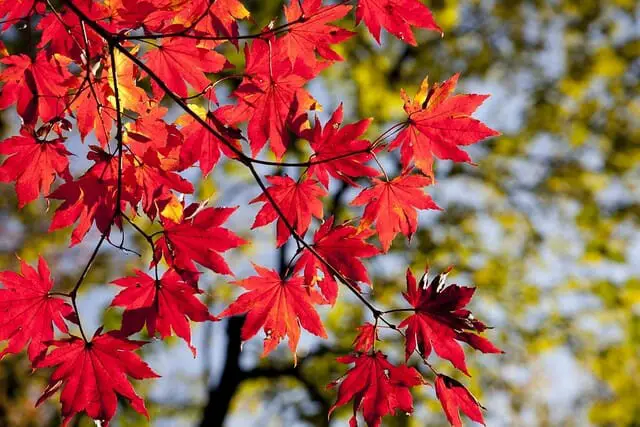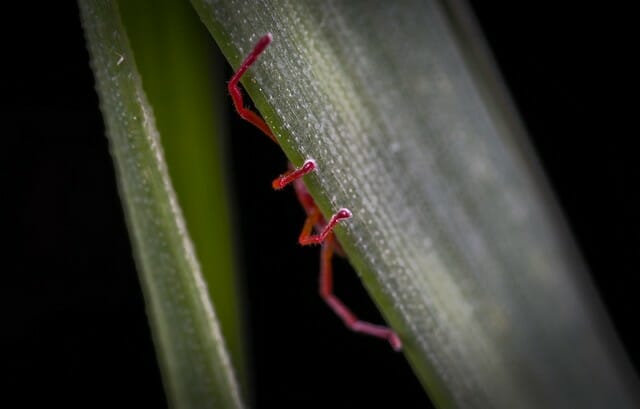Last Updated on April 15, 2022 by Grow with Bovees
Maple leaves are gorgeous, with their vibrant red and interesting shapes—perfect in every sense till gall mites take over!
How do you deal with these well-known maple bladder gall mites that are invading your maple tree?
Read on to find out!
What Are Gall Mites?
Scientifically known as eriophyid mites, Vasates quadripedes gall mites are all of 0.2 mm long when fully grown but bring a world of trouble with them! These minute animals have long, oval bodies and unlike other types of mites that have four pairs of legs, they only have two.
Their size mandates a microscope to view them with and you can detect their presence on plants by the abnormal growths (called galls) that they cause by feeding on the plant.
These mites come in many species, each distinguished by the host they generally feed on. Eriophyid mites generally feed on only single plant species or closely-related plant species.
Similar galls, which can be found on boxelder, pecan and walnut trees, as well as many other trees and plants, are caused by different species of gall mites that are similar in appearance.
The presence of galls causes the foliage to become disfigured and deformed. Galls can also cause some leaves to turn yellow and drop prematurely when they are in plenty.
In rare instances, numerous galls appear to weaken branches or even entire trees. In most cases, mite galls, on the other hand, do very little genuine harm. Unless the galls become incredibly abundant, it is not necessary to use significant control measures.
Plant sap is their food source—they feed on sap by sucking it, secreting chemicals into the plant tissue while doing so. These chemicals convert normal plant cells to meristem tissues, causing abnormal growths which then eventually start producing gall.

Gall mites have a very predictable life cycle. They seek refuge on plants during the winter, underneath and near buds and come spring, when the silver and red maple that’s unknowingly hosting them starts growing, the extremely small mites also grow, feeding and reproducing.
Around two or three eggs are laid each day, with each mite laying a maximum of 80.
Once the maple bladder gall production starts, the mites start sucking sap from the plant cells that line the gall—tastier and more nutritious!
The good thing about gall structures, though, is that they do not cause serious damage to the plant.
Symptoms Of Maple Bladder Galls
While it may be disheartening that there are so many common and well known species of gall mites, the damage caused by maple bladder galls is recognizable and unique to the species.
Some common symptoms are:
- Thickened leaf margins
- Red dots on maple leaves
- Stunted shoots
- Hard-raised structures that have developed on the leaf surface
- Buds enlarging
- Excessive hair growth on the surface of the foliage
- The production of witches’ brooms
- Blisters on the foliage

How Do You Get Rid of Maple Gall Mites?
Though maple bladder gall mites may be a bit of a nuisance, they are not dangerous or damaging to plants.
Therefore, controlling or getting rid of them may not be necessary at all—tolerance is a much better approach. However, knowing how to treat maple gall mites may be useful for you.
There are various ways to control the gall mites affecting your favorite Manitoba maple tree! These include:
- During the dormant season, spray the bark. This is the time when adult mites are overwintering in the bark, which means that they’re not laying any eggs. Ensure that you’re spraying when temperatures are above 40 degrees Fahrenheit and there are no freezing temperatures the following day.
- While pruning your maple tree, check for and remove affected leaves and twigs in early spring, cutting off the spread of mites. Don’t dispose of the cut leaves and twigs near the tree—use a plastic trash bag instead, to prevent spreading.
- Use liquid lime sulfur. Spray red maples with this solution to get rid of mites but ensure that you’re only spraying on trees that don’t have new leaves growing. A hand sprayer for small trees and a pressure sprayer for large trees is recommended. Drench the trunk thoroughly.
- Use insecticidal bark spray. Just after leaf growth starts in the second year is a good time—don’t wait till the bud break in early spring, as galls will have already started appearing by then.
- Make sure your maple trees are well fertilized to keep them in good health.
- Use insecticides that contain carbaryl or insecticidal soap, coating the buds and trunk thoroughly.
If the infestation is light, it is possible to remove gall mites using the above methods. However, the damage to the plants from using the above methods may be more sizable than just leaving the mites alone.
For this reason, most folks leave mites alone and tolerate their presence.
Things You Will Need To Treat Maple Gall Mites
The equipment you’ll need for the above measures include:
- Safety goggles
- A ventilator mask
- Work gloves
- Hand or pressure sprayer, depending on what you’re spraying
- Tarps to cover the surrounding foliage and objects if you’re spraying
- Loppers and pruning shears
- Trash bags (preferably plastic, to prevent the spread)
- Long-sleeved clothes
- Liquid lime sulfur
- Insecticidal soap
- An expandable water hose to wash away any residue
Tips
The following tips will prove helpful when battling mites:
- Healthy red maple trees are at a lower risk of being infested by gall mites; the damage is also much less.
- Wear protective gear at all times when spraying the tree.
- Use tarps to protect masonry and woodwork near the tree that you’re spraying, as lime sulfur can stain these severely.
- Follow your spraying session with a shower and the laundering of your clothing, to ensure that all traces of the spray is removed from you.
Care Of Your Red Maple Trees
Don’t spray chemical insecticides if there are people, pets, or water bodies around. Some folks use dormant oil instead, which is just as effective in deterring mites—however, these can cause damage to red maples as they’re sensitive to these. You may also consider a pet friendly version of whatever it is you choose.
Hope these tips help you keep gall mites away from your maple trees. Try being proactive and prevent the gall mite infestation before it gets to uncontrollable levels.